Spring 2022 Oustanding Biomedical Engineering Design Project Awards
Three student teams were selected by the Biomedical Engineering Advisory Board to receive the Spring 2022 Outstanding Biomedical Engineering Design Project Award. Details on the projects are below.
First Place Team:
Modular Environment Research System (MERS)
Student team members: Lucas Hines, Graeme McCord, John-David Ross, Samarth Vedante, Andrew Williams
Team advisors: Dr. Joel Bumgardner, UofM; Dr. Gary Bowlin, UofM; Ms Kaitlynn Jones, Smith & Nephew
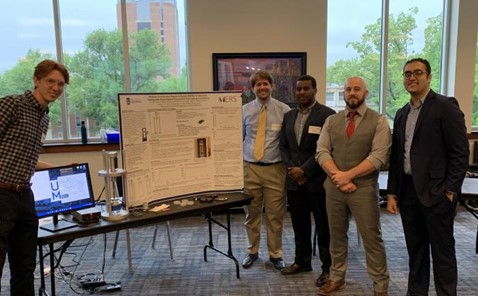
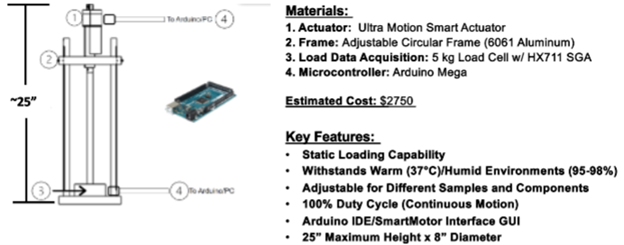
Problem statement
A device is needed for researchers to perform biomaterial mechanical testing in spatially
limited and simulated physiological environments.
A brief description of your design
Our design involved the implementation of a size-adjustable circular frame made with
6061 Aluminum and three upright support rods. An Ultra Motion Smart Actuator was used
to apply static compressive loads to our samples with a 5 kg Load Cell being used
to record real-time loading data. Our system was validated by comparing relevant loading
data gathered in an open-air benchtop environment to data in a CO2 incubator environment.
The future of this design provides a broad range of functionality including cyclic
loading, loading control based on load cell read out, and tensile testing of materials.
Statement of project impact
This project can perform relevant mechanical testing in an incubator environment.
This supports hydration of the biological specimens and allows researchers to control
important environmental factors generally not obtainable in current marketed designs.
This product allows an inexpensive testing system for researchers in academia that
operate with specific budgeting, creating access to material testing for many more,
especially those with a focus in biomaterials.
Brief comment about design experience and what you learned and or acknowledgement
This design experience was unique in providing insights in overlap between different biomedical areas. Adapting to this unique problem, we met with experts in many fields to receive critical feedback allowing our design to achieve the functionality it addresses today. We learned how crucial having a clear and comprehensive design plan as well as a communication protocol can be to creating a successful design.
The MERS team would like to extend our thanks to Dr. Bumgardner, Dr. Bowlin, Kaitlynn Jones, Andrew Blass Watson, Lydia Ross, Dr. Donahue, and Professor Kohn for making this project a success.
Second Place Team:
Thinking Critically
Student team members: Kyra Brady, Michael Diep, Jehad Esmail, Madison Higgins, Julia Strecker
Team advisor: Dr. John Williams
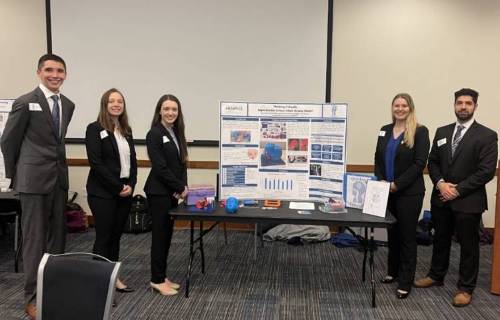
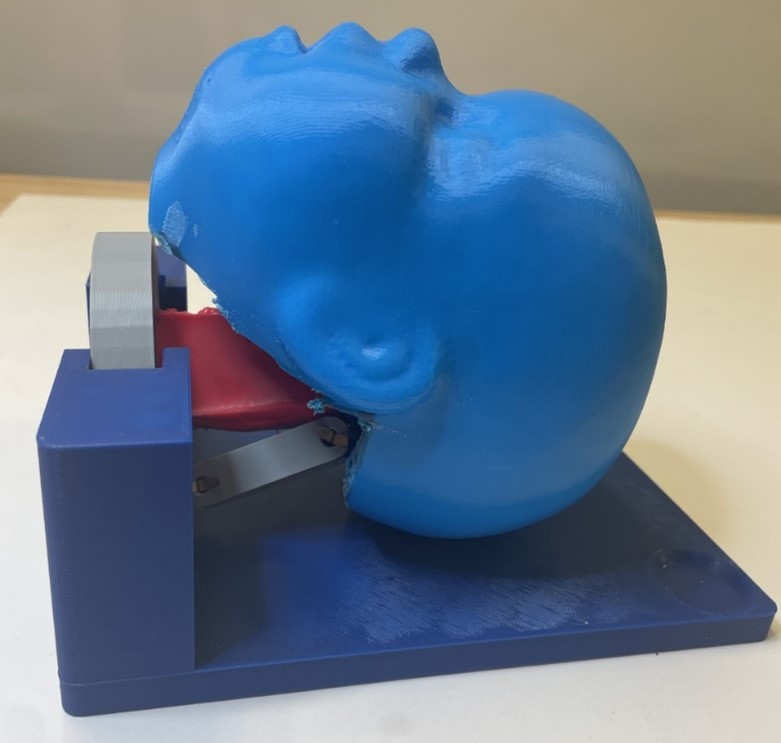
Problem statement
Medical personnel need a reproducible model presenting various anomalies in infants
for the purpose of practicing customized critical airway procedures.
A brief description of your design
The reproducible critical airway model was created for clinicians, medical personnel,
and medical students who practice and perform complex pediatric airway procedures
to mitigate life-threatening anomalies such as retrognathia, cleft palate, and glossoptosis.
It is intended to be used to practice airway intubation procedures. The Thinking Critically
model presents many opportunities for future product development due to its potential
to replicate many critical airway abnormalities beyond those already achieved by the
model. Furthermore, its affordability and versatility present opportunities for continual
sales, company growth, and customer retention.
Statement of project impact
Dr. McLevy said herself that this project will help save babies lives. This model
allows for physicians and students alike to practice patient specific intubations
and develop the muscle memory necessary to execute these procedures. This will help
physicians be better prepared for any situation and not have as much pressure put
on them when needing to clear a critical airway in an infant.
Brief comment about design experience and what you learned and or acknowledgement
Our team learned a lot over the course of semester while working on this project.
Each of us learned how to intubate from Dr. McLevy and learned a lot about a very
specific yet important issue taking over the medical world. We had to learn how to
play to each other’s strengths and work around our weaknesses. This was a great learning
experience and we had a lot of fun working on it too. We would like to thank Dr. Williams,
Dr. McLevy, and Liz Crowder for their continued support while working on this project.
Third Place Team:
Fusion Orthopedics
Student team members: Thaiz Cruz, Jerry Jenkins, Taryn Lema, Shiyanzi Shaikh, Shannon Wallace
Team advisors: Dr. Bernard Grisoni, Bradley Bomar
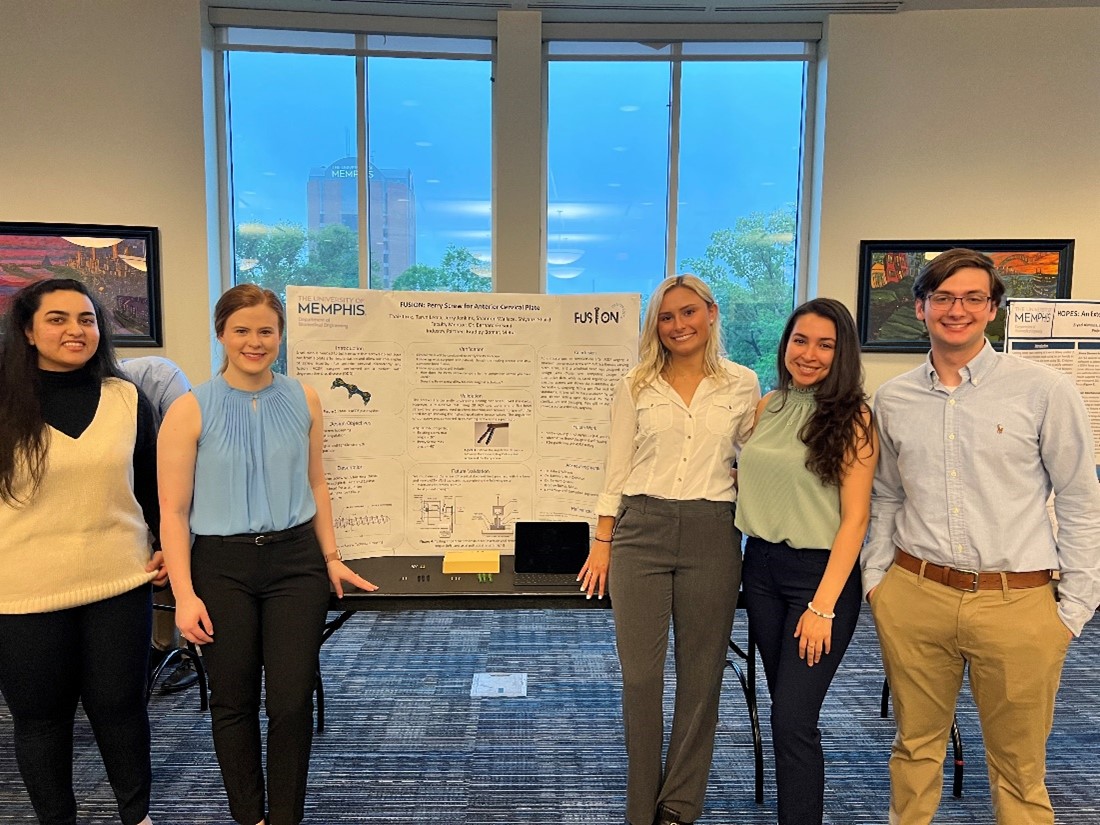
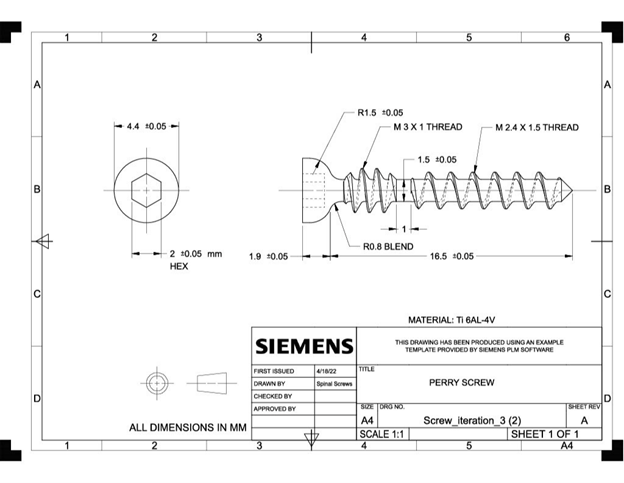
Problem statement
A solution is needed to both ensure that screws do not back out from a plate after
implantation and allows for variable angles of screw insertion for ACDF surgery performed
on a patient with DDD.
A brief description of your design
Our design is a spinal screw with a spherical head and two different thread pitches:
a fine pitch near the head of the screw and a coarse pitch near the tip of the screw.
The fine pitch has a larger outer diameter than the coarse pitch to allow for increased
purchase within the bone. The different pitches, in combination with the compression
zone between them, allows for compression of the cancellous bone to increase removal
torque and axial pullout strength. Also, the spherical head allows for more angulation
of the screw within the plate.
Statement of project impact
The consequences of screws backing out of the plate are serious, often resulting in
severe pain due to failed spinal fusion. To address this problem, our team designed
a compression screw to prevent screw loosening after implantation. In addition, this
screw increases the angulation available to the surgeon during implantation to account
for various vertebral anatomies.
Brief comment about design experience and what you learned and or acknowledgement
This project gave us valuable hands-on experience with the design process, including
how to work to each other’s strengths and approaches to solve complex problems that
arise during the design process.
We would like to acknowledge our mentors, Dr. Bernard Grisoni and Bradley Bomar, as well as Dr. Donahue and Dr. Williams of the Biomedical Engineering Department.

